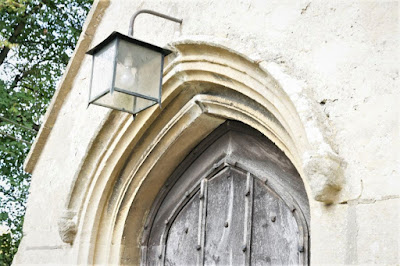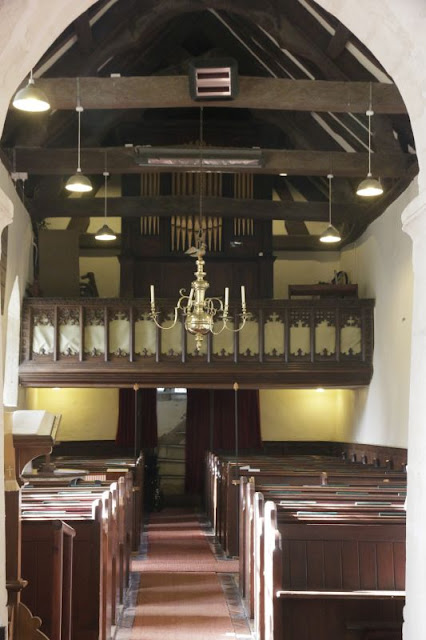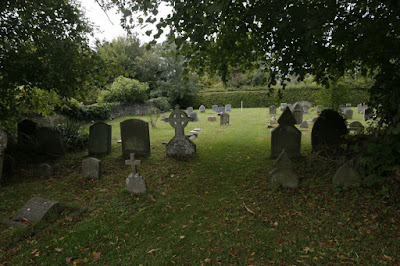Cistercian monks of Beaulieu Abbey built the Church of England parish church of Saint Mary in the 12th century as a chapel of ease. Little Coxwell was a dependent chapelry of the ecclesiastical parish of Great Faringdon. In 1866 the civil parish was established.
The Church of St. Mary's is a 12th Century Chapel of Ease, built by the Monks of Beaulieu Abbey. It contains a number of features of historical and architectural interest, including:
- Norman doorway
- Perpendicular stone porch
- Transitional Priest's door
- Early decorated window
- 3 large perpendicular windows
- 13th Century Bell-cote
- 12th Century Chancel Arch, rebuilt in the 15th Century
- Norman door jambs of the Vestry in the north wall of the nave
- Carved wood rail of organ loft - part of a pre-Reformation Rood Screen
- 15th Century octagonal font
- Iron Hour-Glass stand
- Brass Candelabrum dating from 1729
- George III Coat of Arms
You walk along a narrow lane to find the church and come to this wonderful lychgate
Go though and you are met with a view of the South side of the church
A seat stands to the side of the porch looking towards the Lychgate
Go around to the West end and you find a large window with a rose one above
The North side also had a porch
Though this has been blocked off in the past and a false door placed over where the opening is. The porch is used a vestry
Above the East end window with family vault under it.
Left we look towards the Porch
Standing near you cam look up and see the bells in the cote which dates to the 13th Century
Right one of the headstops on the window
The ones around the door are very eroded

Priest door in the chancel and the door on the porch
Inside another door takes you to the Nave
Looking down you see the 12th century chancel arch which was rebuilt in the 15th century
Above which you can see the George III coat of arms
Through the arch into the chancelm the sreen at the back is tilted
Behind on the East wall are tow recesses, one looks partly blocked in, they look like they were windows once
The Altar dressed in white
On top of which are simple wooden candle holders and a brass altar cross
The The chancel window depicts the Crucifixion and looks Pre-Raphaelite
Looking back through the arch you can see the 1729 Brass Candelabrum

Looking at it from the Pulpit on the right you can see a dove on the top
Looking from the pulpit to the Nave
Another view of the Brass Candelabrum
Looking up at the Organ loft you can see the rails of the loft which is part of a pre-Reformation Rood Screen
Right a view down from the loft, I might add the stairs are some of the most narrow I have climbed
One thing that is worth looking at above the stairs is this Stained glass window, it is something you would miss if you did not go up them

Around the church are plaques with scripture on them, from the look they are enamelled tin and in good condition compared to some I have seen
The George III coat of arms
Not easy to read this memorial even if you are close
Little Coxwell Roll Of Honour, some one hand wrote this with great care and devotion
Right some of the kneelers in the pews
along with hymn books all neatly held
View towards the Pulpit
Before heading back out the Font which is near the door
Outside is a mixture of headstones these near the porch have footstones maching the headstone though one has lost it's top
Looking further west the churchyard has been extended
Though I did not wander through the headstones here are not so old

The headstone on the left with ivy growing up is on the Norths side, at the East end you see this family vault
Looking east here at three headstones beside the path
A Commonwealth war grave of Private A.E.King who died in 1918 age 20. The motive of the Royal Berkshire Regiment prominent on top. Many local men belonged to the Regiment, back then this area was in Berkshire, now it is Oxfordshire
Over the far East side more headstones forgotten by family's
A final look from near the seat.
Till Next time I wish you all a peaceful weekend
Till Next time I wish you all a peaceful weekend












































12 comments:
From some angles outside, it doesn't even look like a church. What a beauty inside.
what a beautiful place!
What a sweet little church. Very English! #InSPIREdSunday
...Bikk, this is a lovely little one!
St Mary's is lovely Bill, the details are a delight to see as always. It is obvious that it is well loved by it's congregation 💙
I really like those old wooden doors, to me those really show the age of the building.
It intrigues me how these old churches look so heavy on the outside but manage to have a light spiritual feeling inside.
A beautiful old church. It was interesting to look back down the nave and see the organ loft and candelabrum and then a view from the organ loft itself. I like the fact that there's a bench where you can sit quietly in the churchyard. Have a good week Bill.
I'm intrigued by that narrow chancel arch, which makes the altar seem so very far away - like in a separate room. I look at my own Inspired Sunday photos this week, also from a 12th century church. There too, there is really quite a distance between the altar and the pulpit and pews. But a much wider arch does not give the same impression of separate rooms.
Hello Billy!
Beautiful architecture and great photos.
Unusual church equipment.
Have a nice week.
This is a wonderful project - quite moving to see how the little church has been looked after inside and to think that some of my ancestors worshipped and are buried there.
janetr
re "One thing that is worth looking at above the stairs is this Stained glass window"!!
I would agree, it is something you would miss if you did not go up to it. VL is for Vicesimus Lush, one time Curate of Faringdon with Little Coxwell. Failing to succeed to become the vicar at Faringdon he migrated to New Zealand with his family.
They left Gravesend, England on the Barbara Gordon at 5pm 16 May 1850. Apart from Vicesimus, there was his wife Blanche and four children Blannie (1843), Charlotte Sarah (1844), Mara Eliza (1847) and Charles 1849. Accompanied by servant Anne (Betsy) Sainsbury. For more details see: https://researcharchive.vuw.ac.nz/xmlui/bitstream/handle/10063/2334/thesis.pdf?sequence=1 and https://visitheritage.co.nz/visit/auckland/ewelme-cottage/
Post a Comment